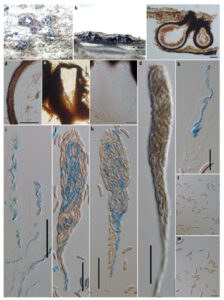Allodiatrypella ananthapadmanabha M. Niranjan & V.V.Sarma sp. nov. Figs.1 a–m
Etymology – In recognition of Dr. Ananthapadmanabhan’s Indian Mycologist for his contributions to Ascomycota.
Index fungorum number: IF558365;
Description
Saprobic on unidentified twig. Teleomorph: Stromata immersed in the bark of deadwood, circular surface black, 3–10 ascomata per stroma. Ascomata 500–600 × 310–410 µm, including necks, perithecial, globose, clustered, single to grouped, immersed slightly raised, long neck long furrow, narrow towards down ostiolate with periphyses with septate within in the ostiolate neck. Peridium 15 µm bipartite, outer thick cortical and medullary thin hyaline in textura angularis cells. Hamathecium paraphyses cellular, numerous, septate with constriction, guttulate. 1–3.9 µm, large cellular, septate, uneven in width, broad base to narrow apical end. Asci 90–182.5 × 15.5–28.7 µm ( = 136 × 22, n=25), unitunicate, pyriform to clavate, broad rounded apical apex, long pedicellate, narrowing down, J-ve in Lugol’s reagent. Ascospores 6.2–12.5 × 2–2.5 µm ( = 8 × 2.2, n=25), multi sporous, sub hyaline, allantoid, rounded ends, smooth walls. Anamorph: Undetermined.
Material examined – India, Andaman and Nicobar Islands, North Andaman, Diglipur, Mohanpur (12˚53’29.8”N 92˚51’28.4”E). Isolated on Unidentified twig, 6 January, 2017, M. Niranjan & V.V. Sarma (PUFNI 17439). South Andaman, Ferrargunj (11˚43’15” N 92˚39’32”E) on Bamboo culms (T302F3) 04 January, 2017.
Notes – Allodiatrypella H.Y. Zhu & X.L. Fan raised in 2020a based phylogenetic results shows that species belongs to Diatrypella distant clustered transferred into the Allodiatrypella. It is also morphologically distinct from Diatrypella in having the clavate to elongate obovoid asci and ascospores pale yellowish to pale brown at maturity. Currently Allodiatrypella consist of six species viz. A. betulae, A. betulicola, A. betulina, A. hubeiensis, A. xinjiangensi and A. yunnanensis. The key and complete descriptions of Allodiatrypella species has provided in (Zhu et al. 2020), in which all the species ascospores are 6-9 µm long except A. yunnanensis (18–22 × 3–4 μm), similarly the ascomata of A. betulae, A. betulicola, A. betulina, A. hubeiensis and A. xinjiangensi larger and smaller asci then A. yunnanensis and A. ananthapadmanabha. The ascomata of A. ananthapadmanabha is larger than the A. yunnanensis (500–600 × 310–410 vs. 360–440 × 245–260) whereas the asci (90–182.5 × 15.5–28.7 vs. 105–210 × 15–30 μm) and ascospores (6.2–12.5 × 2–2.5 vs. 18–22 × 3–4 μm0 are smaller. Therefore the morphological distinct characters of the A. ananthapadmanabha lead to a new species in the Allodiatrypella.
Figs.1. Diatrypella ananthapadmanabha (PUFNI 17439) a Stromata b,c Vertical section c, e Section of Ascomata d Peridium e f Ostiolar neck i Paraphyses g,j,k Asci l, m Ascospores. Scale bars: c=100µm d, e=50 µm f,g,i–k= 20 µm h,l, m=10 µm.

